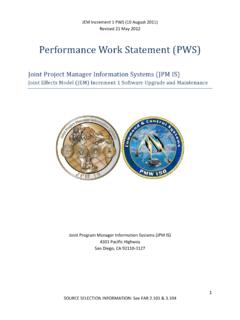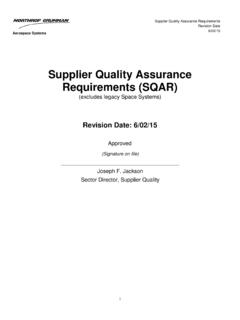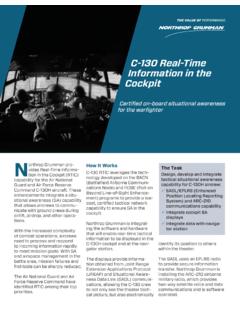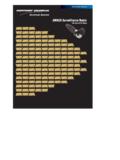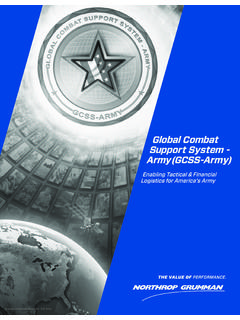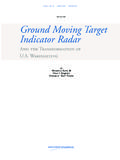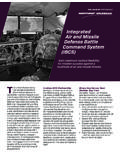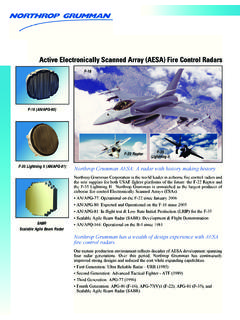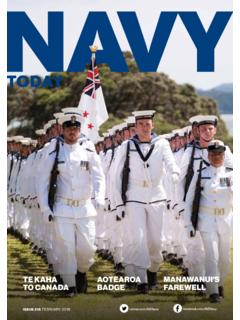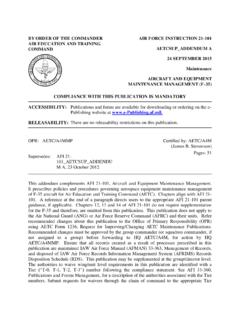Transcription of THE CORPS A Radar for All Missions - Northrop …
1 S E A P O W E R / N O V E M B E R 2 0 1 042 THE CORPSThe Ground/Air Task-Oriented Radar (G/ATOR), designed for the Marine CORPS asan expeditionary multimission Radar , is goingthrough system and integration testing and heading fora planned initial operational capability (IOC) in TPS-80 G/ATOR, which is intended to replace fiveolder Radar systems, also is showing potential to adaptto the requirements of a long-range Radar system undercompetition for the Marine CORPS and Air Force. Northrop Grumman Electronic Systems in Baltimorehas built two production-standard G/ATOR prototypesand is testing them in the environs of Baltimore-Washington International Thurgood Marshall Airport,which provides plenty of air-tracking set was built with Marine CORPS funding, the otherwas built with Northrop Grumman team funding tosupport integration and is designed to detect and track targets rangingfrom manned and unmanned aircraft to cruise missiles toprojectiles from mortars, artillery and rocket G/ATOR system s major components includethe Radar Equipment Group the Radar antenna andits rotating drive system mounted on a trailer thatcan be towed by a truck.
2 The flat-screen antenna arraylies flat for transport and is erected for operational antenna includes hundreds of transmit/receivemodules for the active electronically scanned array(AESA), which bene fited from de -velopment of the APG-81 AESA Radar for the F-35 Lightning IIJoint Strike AESA Radar rotates to provide360-degree coverage, said Jeff Pa -lombo, vice president and generalmanager for land forces programs atNorthrop Grumman. Even while sta-tionary and scanning in one direc-tion, it can focus separate beams onother areas. If the Radar is spinning and itidentifies a threat, it can send the beam to linger onthat threat, he UPX-44 IFF (Identification Friend or Foe) Sys tem,built by Telephonics in Farmingdale, , is installed inthe G/ATOR s Power Equipment Group that includesa generator to provide electrical power for the system ismounted on the truck that tows the Radar trailer.
3 A thirdcomponent, the Communications Equipment Group, is aHigh Mobility Multipurpose Wheeled Vehicle (Humvee)-mounted palletized communications system that trans-mits Radar data to a command-and-control center. The Marine CORPS is developing the Common AviationCommand-and-Control System that in the future willreceive and analyze the data feed from the entire system can be airlifted into an operationalsite by three CH-53E Super Stallion heavy-lift helicop-ters or MV-22B Osprey tiltrotor aircraft, or by a single C-130 transport aircraft. The system is required to be setup on-site within 45 minutes. We will be able to set up that system as designed inless than 30 minutes, Palombo said. The G/ATOR will replace five legacy Radar systemscurrently in Marine CORPS service: the TPS-63 (airdefense), TPS-73 (air-traffic control), MPQ-62 (short-range air defense), TPQ-46 (counter-fire target acquisi-tion) and UPS-3 (target tracking).
4 A Radar for All MissionsThe G/ATOR will replace five older Marine CORPS systemsBy RICHARD R. BURGESS, Managing EditorQuick Set-UpThe G/ATOR will provide the Marine CORPS with a mobile multimissionexpeditionary Radar system. The three-vehicle system is transportable by three helicopters. Active electronically scanned array was developed from mod-ern airborne Radar designs. G/ATOR may satisfy Radar needs for the Air Force and E A P O W E R / N O V E M B E R 2 0 1 043 THE CORPSThe G/ATOR is in its system development anddemonstration phase, with qualification testing sched-uled to begin next year. A decision for low-rate produc-tion is planned for 2013. The Marine CORPS has structured the G/ATOR pro-curement program in four increments. The Corpsplans to procure 69 systems 17 Increment 1, 38 Increment 2 and 14 Increment 4 systems to equipthe various air and ground combat elements, saidDavid Branham, spokesman for the Marine CORPS pro-gram executive officer for land systems.
5 Increment 3, scheduled for 2019, is an enhancementto the other increments that includes some noncoopera-tive target recognition and more enhanced counter meas-ures, upgrades to IFF modes and codes, said Lee Bond,the G/ATOR program manager for the program executiveofficer for land systems. Increment 1, scheduled for IOC in 2016, is all aboutair surveillance, air defense, battlespace awareness, to[give] the Marine Air-Ground Task Force ashore an abil-ity to track everything from friendly and hostile UAVs[unmanned aerial vehicles] to stealthy cruise missilesand tactical aircraft .. and provide all that kind of infor-mation real-time to the forces on the ground, said Bond. Increment 2, scheduled for service in 2017, is designedto perform the counter-battery, or ground-weapon loca-tion, mission . The Radar will be able to detect incomingprojectiles and compute the origins of their launch,enabling friendly forces to return fire at the 2 uses slightly different waveforms,slightly different operator interface, Bond said.
6 Oneof the key nuances here is to translate those two mis-sions, the air defense mission andthe ground defense mission , thatwere done by two completely sepa-rate radars and two different com-bat elements. Now, we re going tohave one Radar that can fulfilleither mission with G/ATOR. In a program change, Increment 4will precede Increment 3 and enterser vice in 2018. Increment 4 will re -place the TPS-73 air-traffic controlradar. We re building [Increment 4] forthe Marine air wing to come ashoreand for the air traffic controllers tokeep track of all the good guys andthe potential hostiles in the air spaceof interest for the Marine Air-Ground Task Force, Bond said. Increment 3 doesn t give younew mission capabilities, but itmakes all the other mission capabili-ties work better, in some cases, against the more advancedthreat set, he said.
7 Increment 3 is not tied to specific sys-tems in the inventory. The need is still there, but in dealingwith fiscal realities of strained budgets, [we ve] got to pri-oritize what the mission needs are. It made more sense toactually deliver the 69 systems with Increments 1, 2 and 4capabilities therein and then come in behind that deliveryschedule with Increment 3 enhancements and makeeverything that s already out there work better. The G/ATOR design has gone through significantchanges since it was originally envisioned. The radaroriginally was intended to be mounted on a Humvee,but real-world circumstances forced a change. Shortly after the contract was awarded, the wordcame back from Iraq and Afghanistan that we had toup-armor all of the vehicles to protect the occupants, Bond said. When you put more armor on the vehicle,it means it can carry less payload, so the idea of takingthe whole G/ATOR Radar and setting it on an armoredHumvee that still has a couple Marines in it [did not]fit anymore.
8 We ran out of space and weight. We looked at how the Army does the Fire-Finderradar, the Radar is built into a truck which pulls its gen-erator, he said. What we ultimately decided to dowas take the generator, put it on a truck, put the radaron the trailer which could be pulled by a 7-ton truckand the Medium Tactical Vehicle Replacement. In theHumvee was the communications equipment group. To figure that out, literally, took the better part ofthe year of design iteration, so that s another thing thatcontributed to the growth in the schedule since theprogram inception in 2005, he Ground/Air Task-Oriented Radar (G/ATOR), designed for the Marine Corpsas an expeditionary multimission Radar , is mounted on a trailer that can bepulled by a 7-ton truck and the Medium Tactical Vehicle Grumman displayed the towable G/ATOR system at its test site atBaltimore-Washington International Thurgood Marshall Airport in GRUMMANS E A P O W E R / N O V E M B E R 2 0 1 044 THE CORPSC ritical to the air mobility of the G/ATOR is its light-weight cooling system.
9 The G/ATOR is designed to oper-ate in ambient temperatures of -40 to +55 degreesCentigrade, with cooling provided by forced circulationfrom fans blowing ambient uncooled air through the array. It s a wide temperature range compared to how inthe past we tried to control the temperature of ourelectronics, Bond said. The whole array has to, with-in a degree or so, have the same temperature. Other -wise, you start to get different performance throughthe different electronics components. The impressive upside of that is how much weightwe saved as well as plumbing complexity because wedon t have to have a two-stage cooling system, headded. [This] helps keep it light and, in our lexicon,light equals mobile and expeditionary. The Marine CORPS is spending approximately $300million on G/ATOR Increment 1.
10 Once delivered, theservice will have the hardware in place for the subse-quent increments, which involve new wave forms, pro-cessing algorithms and some operator interface func-tions, all software-driven changes. I m not trying to suggest that it s easy, but it isn tquite as complicated as a whole other Radar which, ofcourse, was the case in the past .. with different hard-ware, different soft ware, different vehicles, differenteverything, Bond said. G/ATOR ultimately may result in force-structurechanges for the Marine CORPS , Bond said. Currently, forexample, in a Marine aircraft wing, air control squadrons(for air defense) and air traffic control squadrons operatedifferent legacy systems, but G/ATOR might allow theCorps to combine those functions into one type of unit. You can combine how you do maintenance becauseit s a common hardware suite, he said.
